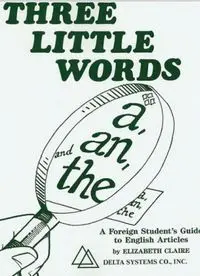
Three Little Words: A, An, and The PDF
Preview Three Little Words: A, An, and The
www.ez-english.narod.ru THREE LITTLE WORDS A Foreign Student’s Guide to English Articles. by Elizabeth Claire www.ez-english.narod.ru www.ez-english.narod.ru INTRODUCTION 0.1 The three words that are used the most often in the English language are 0.2 A, an, and the are a part of speech called articles. Whenever you see or hear an article, you can expect a noun to follow. (A noun is a word that names a person, place, thing, or idea.) 0.3 Sometimes the noun follows directly after a, an or the: a face an apple the pencil 0.4 Sometimes there are adjectives between a, an or the. and the noun. (An adjective is a word that tells about or describes a noun.) a happy face an old rotten apple the short fat pencil www.ez- english.narod.ru www.ez-english.narod.ru 0.5 If you leave out a, an, and the, or if you use them incorrectly, your meaning may still be clear. But it will not sound right to Americans. In some cases it can make a very big difference in the meaning of what you say. a. He has black hair. b. He has a black hair. 0.6 In speaking, the articles are not stressed. They are said quickly and are joined with the word that follows them. It's very hard to hear a, an, and the when Americans are talking. These little words seem to disappear! 0.7 Some languages do not have articles. In other languages there are many forms of articles and they are used in ways different from the way English uses them. Because of these differences, almost everyone learning English has some trouble with a, an, and the. This book was written to help you. www.ez-english.narod.ru www.ez-english.narod.ru HOW TO USE THIS BOOK There are rules that can help you decide when to use a, an, or the, and when to leave them out. Each of these rules has some exceptions. And the exceptions have exceptions! Native English- speakers did not learn these rules in school. They just say "It sounds right this way." This book has TEN STEPS to help you understand how Americans use these words. But the most important way to improve your English is to listen and read. Then the correct way will sound right to you too, when you speak and write. If you are using this book without a teacher, here are some suggestions for you: 1. Relax. If you are nervous in conversation because of limited English, do only STEP ONE and STEP TWO in this book. Listen to native speakers as much as you can, and increase your vocabulary and understanding. Go on to the next steps only when you feel ready. 2. Ask a native-English speaker to help you with the listening and speaking parts in STEP ONE. You will need a native speaker to check some of your answers and the free composition in the mastery tests. 3. Read the rules and sentences, then do the exercises. Check your answers. 4. If you score 100 on any test, that's great! Go on to the next step. 5. If your answers do not agree with the book's answers, re-read the rules in that step. If you have more than four answers wrong, wait several days or longer before you go to the next step. Do not try to complete the book too quickly. 6. After you complete STEP NINE, take the review tests in STEP TEN and check your answers. If you have made any errors, go back to the rules. The number in parentheses tells which rule to see. For example (1.2) is paragraph 1.2 on page 5. 7. Take the MASTERY TESTS. Have a native-English speaker or a teacher correct your sentences. 8. Keep listening for the use of these three little words and notice them in your reading. Ask English-speaking friends to correct you if you are using a, an, or the incorrectly or omitting them where they are needed. www.ez-english.narod.ru www.ez-english.narod.ru STEP ONE: Listen carefully 1.1 Can you hear a, an, and the? EXERCISE: Train your ears to hear these little words. Listen to a native English speaker (or the teacher) read a few sentences at a time from any simple story. Make a mark (/) every time you hear a, an or the. After each item, the reader will tell you how many times a, an, or the appeared in the sentences. Check this against the number you wrote down. I hear: There really are: I hear: There really are: 1. _____________ _______________ 6. _____________ _______________ 2. _____________ _______________ 7. _____________ _______________ 3. _____________ _______________ 8. _____________ _______________ 4. _____________ _______________ 9. _____________ _______________ 5. _____________ _______________ 10. ____________ _______________ Did you improve as you practiced? _____________. Practice a little every day with an English speaker reading to you. I hear: There really are: I hear: There really are: 1. _____________ _______________ 6. _____________ _______________ 2. _____________ _______________ 7. _____________ _______________ 3. _____________ _______________ 8. _____________ _______________ 4. _____________ _______________ 9. _____________ _______________ 5. _____________ _______________ 10. ____________ _______________ www.ez-english.narod.ru
